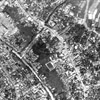Research on the Dongpalane street district
Participation in The Urban Study on Street Network in Vientiane & Hanoi
Call for tender ISTED, project IPRAUS-IRD
>> Ldf 02
|
The study of the transformations in the shopping street of Dongpalane in Vientiane quickly led us to the forecasted disappearance of old villages and of the Nongchanh marsh, revealing the spatial and social organization of groups to ensure their survival. Faced with the fragmentation and the multiplication of constraints, and, in some way, with new control structures, it is through actions (desires) and reactions (resistances) that the pragmatic elaboration of new living spaces is achieved. Within this context, it was essential to spot the various « shapes taken by scattered creation » (1). The field survey revealed singular spaces of the familiar, alternative exchange protocols, new forms of sociability and neighbourly relations, from which we tried to deduce the elaboration process in a geographic and historical perspective: assimilation, appropriation, recombining of endogenous and exogenous cultural models. The Nong Chanh example, an aquatic anthropized area, far from the eyes of passers-by in the shopping street, is representative in this regard. Even though far from operating on their proper field, the inhabitants of the marsh however managed, in a context of shortage (of space, economic resources and individual freedom), to inject and develop their customs made of misappropriations and permanent adjustments on a territory considered as unfit for human settlement. This process led to the creation of a different district in the city, a singular layout of spaces and complementary practices, directly linked to the great Kuadinh market, but invisible from Dongpalane.
|
|
|---|







